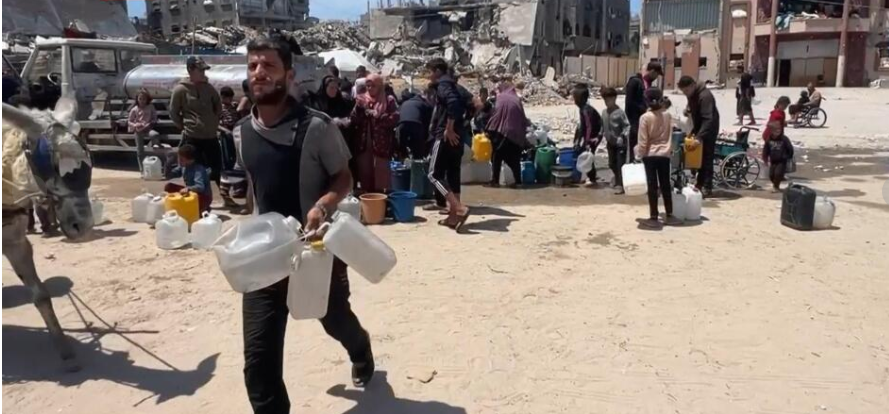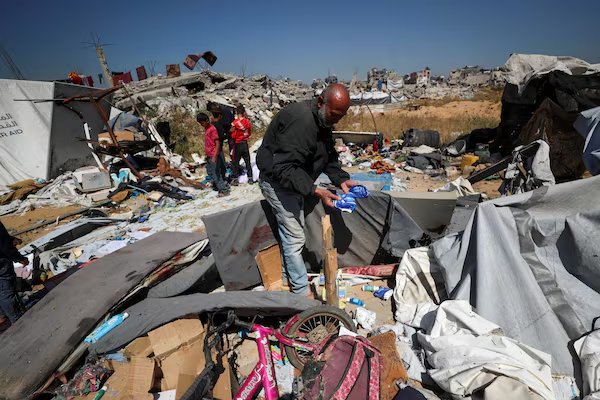Thousands of children in Gaza are enduring severe malnutrition due to the ongoing food blockade imposed by Israel, according to various aid organizations. With limited access to essential food supplies, children are suffering from stunted growth, weakened immune systems, and other health complications. Aid groups are calling for immediate humanitarian intervention to address the urgent needs of Gaza’s youngest, as the blockade continues to worsen the humanitarian crisis in the region.
Humanitarian Crisis Deepens in Gaza Amid Ongoing Blockade and Strikes
In the Gaza Strip, aid organizations are raising urgent concerns over Israel’s ongoing blockade, which has now persisted for over six weeks. The blockade, which has cut off food, fuel, medicine, and other essential supplies, has led to a severe humanitarian crisis. According to the United Nations, thousands of children are now malnourished, and the majority of the population is struggling to survive on less than one meal a day as food stocks continue to dwindle.
The situation has worsened as Israeli airstrikes continue to devastate Gaza. In recent overnight strikes, at least 27 people were killed, including six women and 15 children. The ongoing violence has led to a growing humanitarian disaster.
In a joint statement, leaders from 12 independent aid organizations warned that Gaza’s humanitarian aid system is facing complete collapse. Many organizations have been forced to halt operations due to the increasing dangers posed by the Israeli bombardments, which have intensified since March 18.
Since the blockade was imposed on March 2, no food, fuel, or medical supplies have been allowed into Gaza. The renewed airstrikes and the Israeli military’s seizure of large areas in Gaza are part of a strategy to pressure Hamas into releasing more hostages. However, this has come at a devastating cost, with hundreds of deaths and more than 400,000 Palestinians being displaced from their homes.
As the conflict continues, the international community is calling for urgent action to address the escalating humanitarian crisis in Gaza.

Latest Strikes in Gaza: Dozens of Civilians Killed, Including Children
Recent Israeli airstrikes across Gaza have resulted in significant civilian casualties. In the southern city of Khan Younis, a single strike killed a family of ten — five children, four women, and a man — according to Nasser Hospital, which received the victims’ bodies. In northern Gaza, two other couples and their nine children were reportedly killed in separate strikes, as confirmed by staff at the Indonesian Hospital.
Later in the day, another airstrike struck a school in Jabaliya that was being used as a shelter for displaced residents. That attack killed at least three adults and a child. The blast left severe destruction — classroom walls collapsed, and debris including burnt mattresses and food cans were scattered across the site.
The Israeli military continues to carry out daily strikes on homes, shelters, and public areas. Officials state these operations target Hamas militants, who they say embed themselves in civilian areas. The military also claims to take measures to minimize civilian casualties. There has been no immediate comment from Israeli authorities regarding the latest series of airstrikes.
Gaza Faces Worst Humanitarian Crisis in 18 Months: Millions Rely on Charity Kitchens
The humanitarian situation in Gaza has reached a critical point, with nearly all of its more than 2 million residents now dependent on charity kitchens for daily meals, according to the United Nations Office for the Coordination of Humanitarian Affairs (OCHA).
These kitchens, however, are only able to prepare around 1 million meals each day—mostly limited to rice or pasta, without fresh vegetables or meat. Other food distribution programs have been forced to shut down due to a lack of supplies, and remaining food stocks from the UN and various aid organizations are being redirected to these charity-run facilities.

In Gaza’s markets, where food is still available, prices have skyrocketed and shortages are widespread. Fresh produce and meat are nearly impossible to find. According to the World Food Program’s April report, 80% of Gaza’s population now depends on humanitarian aid as their main food source.
“The Gaza Strip is now likely facing the worst humanitarian crisis in the 18 months since the war began,” stated OCHA.
Bushra Khalil, Policy Head at Oxfam, highlighted the severity of the crisis:
“Kids are eating less than a meal a day and struggling to find their next meal. Everyone is purely eating canned food. … Malnutrition and pockets of famine are definitely occurring in Gaza.”
The situation continues to deteriorate rapidly, with urgent calls from international organizations for increased access and aid to prevent further loss of life.
More hungry children, and harder to reach
According to the United Nations Office for the Coordination of Humanitarian Affairs (OCHA), the number of children suffering from acute malnutrition has surged dramatically. In March alone, over 3,600 children were newly admitted for treatment—an alarming increase from just 2,000 in February. OCHA warns that “the rapid deterioration of the nutrition situation is already visible.”
Humanitarian organizations are struggling to respond, with their efforts severely hampered by ongoing airstrikes and ground operations in the region. As a result, only 22,300 children under the age of five received essential nutrient supplements in March—a steep 70% drop compared to the previous month.
Adding to the crisis, only about 100 out of the 173 original treatment centers remain operational, drastically limiting the ability to provide life-saving care.
Read Also















 Categories
Categories









